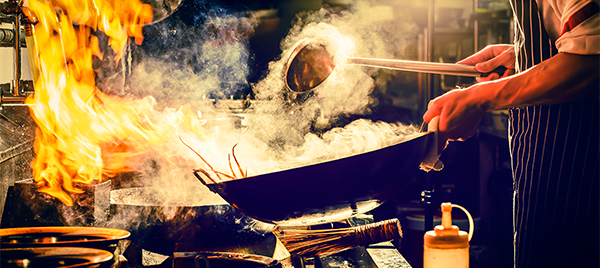Douse a fire before it starts with these 31 restaurant fire prevention tips
Here’s a “hot” statistic for you: In the U.S., restaurant fires cost approximately $165 million every year, according to the National Fire Data Center. If the fire is quickly confined, its cost may be capped at approximately $1,000, but an uncontained fire can cost $60,000 on average. That’s why we’re presenting these 31 restaurant fire prevention tips to our restaurant owner clients – to help you eliminate or at least limit your exposure to fire loss.
Remember: fires may not only damage your property, but also cause injuries to employees and guests, compounding your property loss with liability and workers’ compensation losses.
Restaurant fire prevention tips in the kitchen
Open flames. Cooking oils. Hot equipment. Fast-moving employees. Your kitchen is full of potential fire sources. These 11 tips will help prevent fires.
- Install an automatic fire-suppression system in the kitchen. Why is this critical? Because 57 percent of restaurant fires involve cooking equipment. While these systems automatically dispense chemicals to suppress the flames, they also have a manual switch. Activating the system automatically shuts down the fuel or electric supply to nearby cooking equipment.
- Have your fire-suppression system professionally inspected semiannually. The manufacturer can refer you to an authorized distributor for inspection and maintenance.
- Wire your exhaust fan to turn on automatically when you turn on your cooking appliances. Fire suppression systems are designed to automatically activate when a system detector reaches a specified temperature. Without the exhaust fan running, heat builds up, sets off one of these detectors, and discharges the system.
- Once your fire suppression system is in place, don’t move your equipment. These systems are carefully designed based on your specific cooking equipment and the placement of the equipment. If you change an appliance or move an appliance even by a small amount, your fire system may not extinguish a fire.
- Keep portable fire extinguishers as a backup. Employ Class K extinguishers for kitchen fires involving grease, fats and oils that burn at high temperatures. Class K fire extinguishers are only intended to be used after the activation of a built-in hood suppression system. Keep Class ABC extinguishers elsewhere for all other fires (paper, wood, plastic, electrical, etc.).
- In the event of a fire, activate the fire suppression system before using a hand portable fire extinguisher. When the system is activated the electric and gas feeding the appliances are automatically shut off, which reduces the risk for re-ignition after initial extinguishment. Cooking oils have an ‘auto-ignition’ temperature, meaning that once the oil reaches that temperature, it can ignite without a spark or flame. In the event of a fire, if you were to use the hand portable extinguisher first, there is a strong possibility the fire will re-ignite with the fuel source still being active.
- Regularly inspect cooking equipment to ensure it’s clean and well maintained. Failure to keep equipment in full working order and identify any potentially dangerous mechanical faults could cause a fire.
- Have your exhaust system inspected for grease buildup. The NFPA Fire Code calls for quarterly inspections of systems in high-volume operations and semiannual inspections in moderate-volume operations. Monthly inspections are required for exhaust systems serving solid-fuel cooking equipment, such as wood- or charcoal-burning ovens.
- Don’t wedge open fire doors. They only work when they’re closed
- Keep fire escape routes free from obstructions.
- Ensure emergency lights are working and exit signs are visible, both in the kitchen and in the dining areas.
Related: Best practices for reporting workplace incidents
Restaurant electrical fire prevention tips
The second leading cause of fires in the restaurant industry is electrical fires. They are also the leading cause of larger, non-confined restaurant building fires. Often, they can be prevented with routine maintenance and employee training. Common causes of electrical fires in restaurants include extension cord use, overloading electrical systems with too much equipment, or storing combustible materials too close to an electrical panel. Steps to prevent electrical fires include:
- Begin a regular maintenance and inspection program, if you don’t already have one.
- Train your staff to identify hazards, such as locating breaker switches, identifying unsafe electrical cords and how to report hazards.
- Hire only qualified contractors that are properly licensed to perform electrical work.
- Schedule regular maintenance on electrical equipment, and watch for hazards like frayed cords or wiring, cracked or broken switch plates and combustible items near power sources.
Restaurant fire prevention tips outside the restaurant
A Cherry Hill, New Jersey restaurant along with a neighboring restaurant were destroyed by fire a few years back when a lit cigarette was tossed into a mulch pile. The fire smoldered until after closing time. By the time the fire department was able to extinguish it, both buildings had incurred substantial damage.
Since practically every state has laws prohibiting smoking in public places, smokers are forced outside, tending to congregate in areas around the restaurant where there’s shrubbery and mulch. These fires can slow-burn for hours due to smoldering “tunnels” under the surface that later break out into open flame, reports Zurich in their restaurant fire exposure guide. They provided these tips to prevent exterior fires:
- Keep mulch at least 18 inches away from combustible building materials, such as wood, vinyl siding and decks.
- Provide proper receptacles (such as “butt outs”) for smoking materials at all entrances and in designated smoking areas. Place them at least 18 inches from the building, and do not mulch in these areas. Empty receptacles regularly.
- Keep mulch beds moist when possible.
Related: How reporting a business claim promptly saves money
Your restaurant fire prevention tips should incorporate the possibility of arson. Preventing intentional fires is similar to preventing burglaries in terms of actions and equipment. In addition to having a quality burglar and fire alarm system, take these precautions, provided by Zurich:
- Outer fences, walls and gates should be high and strong.
- Gaps under doors should be as small as possible.
- Don’t keep stored materials stacked outside.
- Ensure that outside lights are turned on and illuminate properly.
- Keep dumpsters padlocked with a high-quality lock.
- Ensure that all flammable materials are stored in a secure area.
Train your staff
We recommend at least monthly training sessions, given the turnover rate of restaurant staff, to ensure your team is up to speed on fire safety. Use these tips provided by Fire Safety Inc.
- Train all employees on how to find and use the appropriate fire extinguisher.
- Never throw water on a grease fire. Water tossed into grease will cause grease to splatter, spread and likely erupt into a larger fire.
- Remove ashes from wood- and charcoal-burning ovens at least once a day. Store ashes outside in metal containers at least 10 feet from any buildings or combustible materials.
- Ensure cigarettes are out before dumping them in a trash receptacle. Never smoke in or near storage areas.
- Store flammable liquids properly. Keep them in their original containers or puncture-resistant, tightly sealed containers. Store containers in well-ventilated areas away from supplies, food, food-preparation areas or any source of flames.
- Tidy up to avoid fire hazards. Store paper products, linens, boxes and food away from heat and cooking sources. Properly dispose of soiled rags, trash, cardboard boxes and wooden pallets at least once a day.
- Use chemical solutions properly. Use chemicals in well-ventilated areas, and never mix chemicals unless directions call for mixing. Immediately clean up chemical spills.
Incorporate these 31 restaurant fire prevention tips into your safety manual at your eatery, and train employees on these tips regularly.
Sources:
Restaurant Fire Prevention Overview
Restaurant fire risks: Not just for kitchens
Commercial Kitchen Fire Safety: Statistics for Restaurant Owners
This article originally appeared on Arrowhead Tribal’s blog. It has been slightly modified and updated to better fit the needs of our ACM clients.

